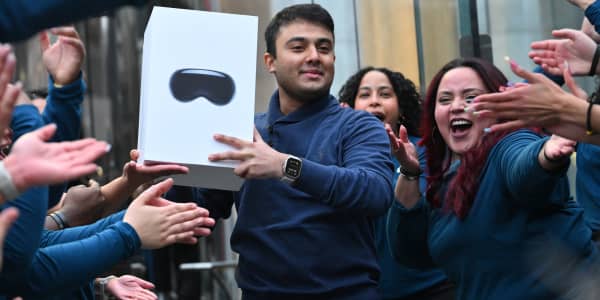It's not surprising that 2016 may be labeled the year of virtual reality.
Headsets from Oculus, HTC and Samsung are already on the market, and Sony is already warning about expected supply demand for its PlayStation VR unit that launched in October.
Indeed, video games have been the poster child for this generation of virtual reality. A lot of the conversation around the technology has been focused on its ability to open up a new avenue of immersion and game play (as well as revenue for game publishers). But VR goes a lot further than the video game world. There are a number of other industries that are hoping to take advantage of the technology — and a number of companies hoping to capitalize on its spread to new fields.
1. Retail
It's one thing to explore a retailer's selection of items via online shopping, but virtual reality can change the way people explore a store. Trips to a furniture or even car showroom can be shortened significantly as potential buyers winnow down potential selections from home. At the National Retail Federation's Big Show in January, digital marketing company SapientNitro demoed a virtual shopping experience that transported people to a tastefully furnished SoHo apartment. When users focused their attention on a particular furniture piece, they got pricing and other information, then could add it to their cart with a simple tap. Lowes, meanwhile, has launched what it calls a "Holoroom" in 19 locations around the country.
Visitors to these stores can take part in a VR experience that lets them design their dream bathroom or kitchen in a virtual space, then step into it and share with friends via a YouTube 360 video.
2. News gathering and dissemination
Outlets from the New York Times to ABC have launched VR news storytelling units, but few have jumped in quite as enthusiastically as Verizon and AOL's Huffington Post, which bought Ryot, a VR breaking-news service earlier this year for somewhere between $10 million and $15 million. The service now provides VR news videos about subjects ranging from Donald Trump to the Nepal earthquake.
"As anyone who's ever experienced VR on a headset or 360 video on your phone knows, the possibilities are powerful," Huffington wrote when the deal was announced. "And Ryot brings all the tech know-how that make these experiences possible."
3. Advertising
Ad companies are adopting a soft-sell approach to VR advertising right now, creating content around the lifestyle a company's brand embraces. Mountain Dew did so last year with "Dew VR Snow," which allowed owners of the Samsung's Gear VR headset to go heli-skiing in Utah with pro snowboarders. It ultimately became the most watched video for months on the headset. The debate in the ad world, though, is about what form advertising will take as VR becomes more mainstream.
"If you're in an interactive experience, you don't want to stop and have a commercial break," said Anthony Batt, co-founder and executive vice president of Wevr, during a panel at this year's SXSW Interactive conference. "The creators that have brands participate with them need to hold that line and say, 'In an immersive experience, it would be really toxic to have a brand interrupt.'"
4. Hollywood films
We're still a few years off from a tentpole film in VR, but many of Hollywood's biggest names, including Ridley Scott, Steven Spielberg and J.J. Abrams, are already working on projects using the technology. And short VR films have already been screened at film festivals like Sundance and Tribeca. It's an intimidating technology for directors, as it turns control of the film's focal point over to the viewer, but it can bring the audience deeper into the story.
While Hollywood looks for the best use, VR headset owners can already download films like "Gone" (a two-hour film broken into 10-minute segments) on their Samsung Gear VR and, soon, the animated film "Henry" on their Oculus Rift.
5. Music
It's tough getting front-row tickets to your favorite musical artist, but with VR you can experience the best seat in the house. Music companies are already exploring the role the technology can play in live music experiences, including giving fans who are unable to attend shows a virtual premium seat — or perhaps onstage access.
Others are exploring how VR and music videos can work together, with artists potentially sharing and monetizing their music in ways that currently aren't possible. And some artists, like Paul McCartney, are using VR to connect with fans and tell the stories behind some of their greatest hits.
6. Health care
Neurosurgery is an extremely delicate operation, so a company called Surgical Theater is helping surgeons prepare for operations by blending VR and techniques learned from flight simulators. Standard two-dimensional brain scans are stacked to create a 3-D model, which surgeons can then explore (or "fly through") in a 360-degree view before the surgery, spotting critical issues that need to be addressed and potential trouble spots.
It's not only helpful for doctors, it also helps patients get a better sense of what will occur during the procedure, which can help put them at ease.
7. Travel
At the Lufthansa gate at Berlin's Schönefeld Airport, people awaiting their flight have a new way to entertain themselves. The airline has installed a number of public VR kiosks so travelers can pass the time with, say, a virtual jaunt to Miami before they board. Qantas Airlines, meanwhile, launched a video in the Oculus store last year about Hamilton Island, a vacation destination along the Great Barrier Reef. Since then, it has been downloaded more than 35,000 times.
Travel officials say VR can inspire travel, let airlines steer customer attention to things like service (rather than cost) and be a wonderful source of in-flight entertainment.
8. Sports training
The quarterback on the University of Arkansas' football team runs many of the same drills as his contemporaries on other teams, but the practice doesn't end on the field. Last year Brandon Allen (who has since been drafted by the Jacksonville Jaguars) used VR to improve his game. Arkansas uses Strivr, a sports-focused VR company, to improve player skills.
The system positions a camera on the field during practices, letting players (primarily quarterbacks) and coaches relive plays as many times as necessary to see what they should improve upon. In other words, more knowledge, less wear-and-tear on the body. The NBA's Washington Wizards and NHL's Washington Capitals have both signed on as Strivr customers as well.
9. Space travel
For the past three years, NASA has used the Oculus Rift to help astronauts learn to control a robot's arm so they can "see" what it's like to be inside an alien world. Scientists at the Jet Propulsion Laboratory at the California Institute of Technology say they hope to use VR as part of a method to make future space missions more immersive, giving them better control over the tools they use to explore and how they interact with any discoveries.
10. Adult entertainment
With any new technology, the adult entertainment industry is often the first to capitalize on it. And porn companies are already swarming on VR. Naughty America, which has shown its product at CES and E3 (the video game industry's annual convention) this year, says 1 percent to 2 percent of our membership base already streams and downloads VR content — and that number is growing faster than any format the company has every tracked. Another company, AliceX, lets users talk directly with a live model and charges a per-minute rate.




